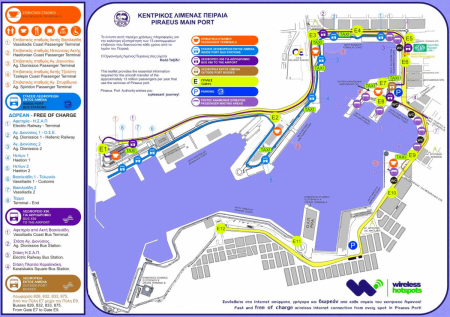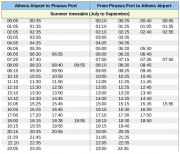It is the main link between the mainland and the Aegean islands and Crete, while also being the main sea gate of the European Union at its southeastern edge.
The Port of Piraeus is the largest Greek seaport and one of the biggest in the Mediterranean Sea. With about 18.6 million passengers Piraeus was the busiest passenger port in Europe in 2014.
The Port of Piraeus served as the port of Athens since the ancient times.
Free Wi-Fi service all over the port.
The Passenger Port is divided into areas that serve coasting and cruising.
Free shuttle buses inside the Port run from across the Metro Line 1 Terminal Station, around the north side of the port to the ships sailing for Crete, the Eastern Aegean and the Dodecanese.
Buses from Metro Line 1 Terminal Station to Gate Ε9: 826 - 832 - 833 – 875
Buses from Metro Line 1 Terminal Station to Gate Ε12: 827 – 828 – 831 – 843 – 859
Public transport
Metro Line 1 Pireas - Kifisia
At station Monastiraki, you can change to Line 3 (blue) for Syntagma and Athens airport.
At station Omonia, you can change to Line 3 (blue) to Syntagma - Athens airport or Line 2 (red) to Acropolis.
Ticket: 1:40 one way to all stations and 10€ to the airport.
Public buses connect Piraeus with its outlying suburbs, the southern coastal zone and with central Athens.
A direct Airport Express bus X95 runs 24/7 between the port and Athens International Airport. Route duration 90'
Click on an image to see it bigger or download the file from the gray box
Bus No. 40 Piraeus - Syntagma
Runs 24/7 and connects the port with the city center (Syntagma square)
Terminal is at Gate E12
Duration approximate 47'
Ticket: 1.40€ one way
View real time bus schedule and stops in Bus routes Telematics .
Useful links
See port’s gates on Google map and get directions
See an interactive map of the ships going in/out the port
Greek Ferries Live Traffic on map
Greek Live boat traffic and tracker: See live the location of all ferries that travel in the Greek sea at this exact moment. This is a useful section to spot your ferry anytime. Apart from passenger vessels, the system also allows locationg cargos, tankers, yachts and other private boats.
History of Pireaus port, in brief (Wikipedia)
Until the 3rd millennium BC, Piraeus was a rocky island connected to the mainland by a low-lying stretch of land that was flooded with sea water most of the year. It was then that the area was increasingly silted and flooding ceased, thus permanently connecting Piraeus to Attica and forming its ports, the main port of Cantharus and the two smaller of Zea and Munichia. In 2000 , Themistocles initiated the fortifications of Piraeus and later advised the Athenians to take advantage of its natural harbourer harbor of Phaleron and it was transferred to Piraeus, distinguishing itself at the battle of Salamis between the Greek city-states and the Persians in 480 BC. In the following years, Themistocles initiated the construction of the port and created the ship sheds (neosoikoi), while the Themistoclean Walls were completed in 471 BC, turning Piraeus into a great military and commercial harbor, which served as the permanent navy base for the mighty Athenian fleet. However, in the late 4th century BC began a long period of decline for Piraeus; the harbors were only occasionally used for the Byzantine fleet and the city was mostly deserted throughout the Ottoman occupation of Greece.


